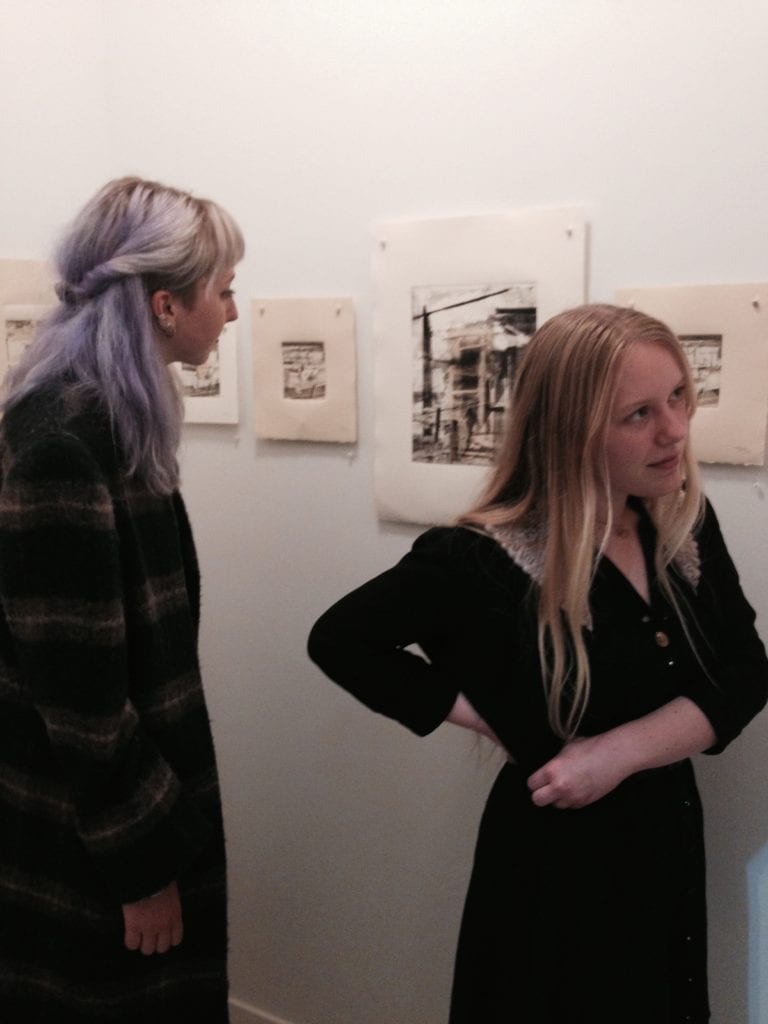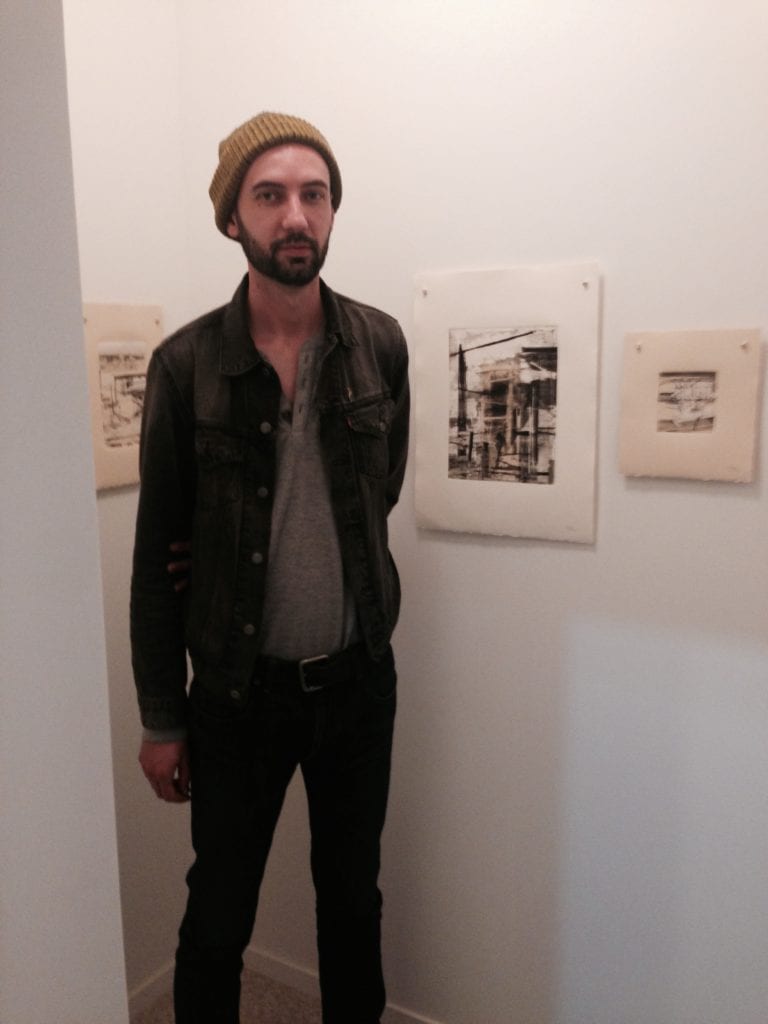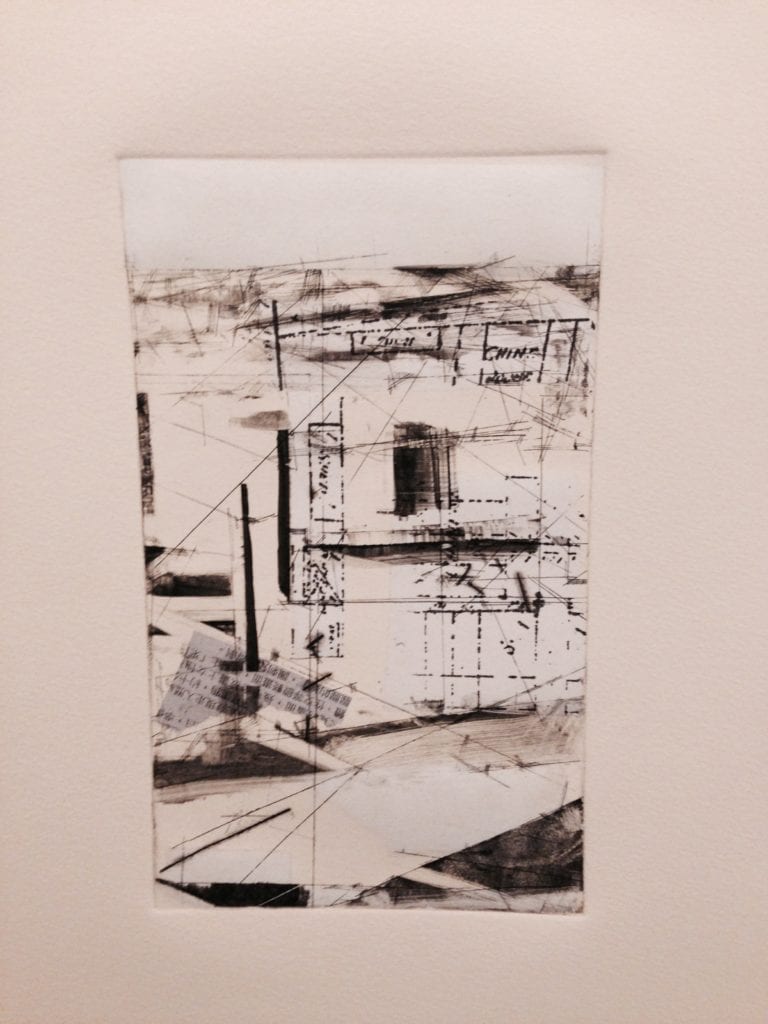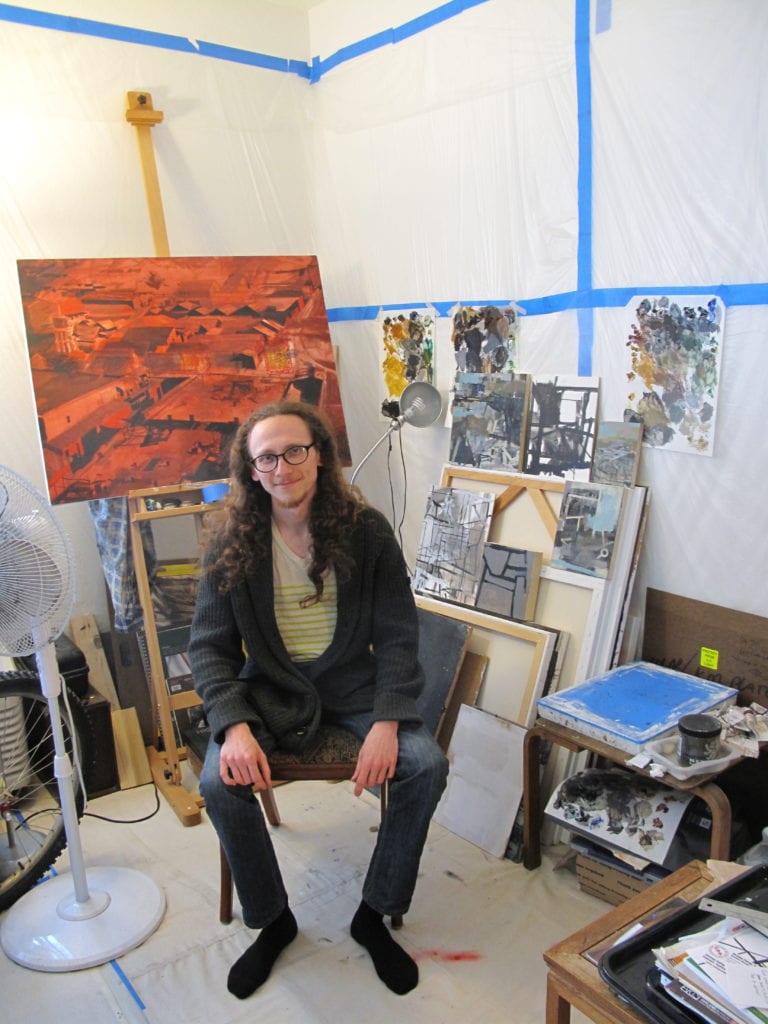
By Murray Schneider
Bird & Beckett Books and Records, already a Glen Park cultural hub, is morphing into a neighborhood art gallery. Long a Mecca where one can obtain new and used books, enjoy poetry recitations and book talks, purchase used vinyl records and listen to jazz and Americana music, the Chenery Street bookshop now will host month-long exhibits of works of art.
Gallery Ex Libris, which experienced its grand opening before 30 people on February 5 when it featured 15 original imprints of San Jose artist Robbie Sugg, is the brainchild of bookseller Eric Whittington’s son, Jack Whittington.
“I’m an artist,” Whittington said, on a recent afternoon, sandwiched into what was once a postage stamp-sized storage closet, but now serves as a setting for him to mount his first exhibit. “It’s more and more difficult these days for artists to get into galleries and this is an opportunity for them.”

Lots of galleries are closing,” he continued. “Rents are skyrocketing, and it’s a good time to feature such an independent space.”
And what can be a better space than in one of San Francisco’s few remaining independent bookstores?
Jack Whittington’s cranny, though, might tax the composure of a claustrophobic.
“It was a broom closet and filled with a bunch of junk before we cleaned it up,” said Whittington, as he surveyed the freshly painted gallery walls, illuminated by new lighting.
Local artist Robbie Sugg’s prints hung behind him, and at the opening of Sugg’s solo exhibit, the artist and Whittington moved between the gallery and bookstore.

Robbie Sugg, at 27, is neither a stranger to Glen Park nor a newbie to the art world. He earned a degree from San Jose State University in painting and printmaking, minored in Japanese and writes poetry.
“Robbie lives in San Jose now, but spent time in Glen Park,” said Whittington, who until recently worked at Bird & Beckett. “He’s given readings of his poetry in the bookstore.”
“My parents were both musicians and would take me in the summer to a Mendocino music camp, which is where they met Betty Wong who lives on Bosworth Street,” Sugg explained. “We lived in Concord and I learned guzheng, a Chinese classical string instrument, from Betty. I’d take BART in from the time I was 11, and when my lesson was over I’d head for Bird & Beckett.”
“I loved milling around Eric’s store. Ever since, I’ve enjoyed inhabiting businesses that are threatened with going under such as coffee shops, bookstores and galleries.”
The demise of such valued “third places” hasn’t gone unnoticed by Jack Whittington.

“We’ve long promoted arts such as poetry and music,” he said. “But now we can do the same with the visual arts, as well as becoming a gathering place for artists who simply want to hang out and support one another.”
“What Jack has done here,” said Sugg, “is in the tradition of the Mission’s Adobe Books Backroom Gallery. Aware of escalating rents, which are pricing out gallery space, Jack is supporting the art scene, moving it to peripheral walls.”
Jack Whittington’s own graphic art is no stranger to Glen Park audiences. He designed the iconic Bird & Beckett logo embossed on the store’s T-shirts, tote bags and bookmarks, as well as the 2014-edition cover for his brother Nick Whittington’s poetry anthology, “Amerarcana.”
Now he’s doubled-downed with the Ex Libris crest.
A graduate of San Francisco State University in American history and earlier a student at the San Francisco Art Institute, Whittington grew up in the Inner Sunset and now lives in the Richmond District. Exiting his father’s bookstore, he’s now applying for graphic design jobs, possibly as an illustrator.
But Gallery Ex Libris ensures he’ll not stray far from Glen Park.
“My plan is to take submissions from local talent such as Robbie, not necessarily confining Ex Libris to prints and to curate different artists monthly,” said Whittington, who found a muse in Bruce Conner, the Sussex Street artist who worked in a wide array of styles and mediums. “Artists can contact me through the gallery website or pick up a business card outside the gallery.”
“What always amazes me is that some people don’t know Glen Park exists,” he said. “I liked working here where everything feels so personal.”
“And the people who attended the opening, they got it,” Robbie Sugg said about his collection of prints. “It was gratifying talking with them.”
Anyone who takes in Sugg’s show from now until the end of the month can see his prints serve a purpose other than simply showcasing art for its own sake.
San Jose, California found itself, in 1887, five years after the Chinese Exclusion Act, going through massive “beautification” to complete its modernization. The city had been newly electrified and it saw its Chinatown, centered around San Fernando Street, as an eyesore, as an impediment to its redevelopment plans.
“San Jose for years had tried to legally remove the Chinese from the very heart of the city,” said Sugg. “Then a mysterious fire broke out in the dense wooden enclave of over a thousand immigrants, resulting in the fragmentation of the Chinese community, which was then dispersed to various smaller pockets throughout the valley.”
Sugg’s collection of prints is a hybrid of different techniques: lithograph, etching, collage and monoprinting that visualize this demographic disruption in impressionistic form.
“I turned 1885 fire insurance maps of San Jose’s Chinatown into lithographs, which I then tore and collaged into abstract cityscapes,” he explained about his renderings.
“To me this speaks to the scattering of once tightly-knit communities,” he said. “It could be seen as an early case of urban renewal and forced gentrification, symbolically representing the fragmentation of any working class/immigrant/marginalized community displaced by socio-economic forces.”
“Even today, although the Santa Clara valley has a huge Chinese population and a thriving Japantown, there’s no Chinatown left to speak of, and most people don’t know there was ever a Chinatown in the first place.”
This from a boy whose parents lived on a commune in Lafayette and allowed him to ride a BART train from Contra Costa County to the big city before he claimed adolescence. At liberty, he explored a neighborhood where a music teacher named Betty Wong still lives only a few blocks from a bookshop named after a horn player and a playwright.
“Gallery Ex Libris is a vibrant space,” said Robbie Sugg. “And what could be better after you spend time there than spending hours reading a book and listening to jazz.”
Four days after Jack Whittington’s gallery opened, Lilly Hope and Megan Corkill, two students from the San Francisco Art Institute, wandered into Bird & Beckett for the first time. They sat beneath the back window that overlooks Wilder Street. After a while, Lilly Hope stood and stepped into the gallery.
It took a moment or two for her to compute what she was seeing.
“What a tiny, tiny gallery, so nice and intimate,” she finally said, “and so that local artists are supported.”
“Glen Park’s a rare neighborhood,” Jack Whittington had summed up only days earlier. “Distinctive and ever so small.”
Small like Gallery Ex Libris, but, then, less is more.
For more information about Gallery Ex Libris go to www.galleryexlibris.com or if you are an artist and wish to be showcased, go to hello@galleryexlibris.com.